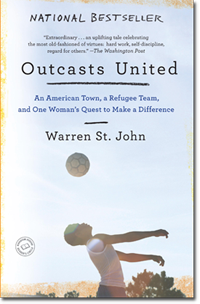Excerpt
THERE WAS A player on the Fugees who was plainly less gifted at soccer than his teammates—a tiny defender from Afghanistan named Zubaid. In retrospect, it seems he might have been farsighted. When the soccer ball rolled his way, he would draw his foot back, swing his leg with all his might, and as often as not, miss the ball entirely, with all the awkward, unalloyed zeal of a batter swinging for the fences and whiffing. After this happened a third or fourth time, I asked Luma what the boy’s story was; his presence on the field was so awkward that it required some sort of explanation. Luma didn’t seem the least bit offended. In fact, she seemed especially proud that Zubaid was on the field. He had never missed a practice or one of the afternoon tutoring sessions Luma required of her players, she explained. He was on the fi eld simply because by the standards she’d established for the Fugees, he deserved to be.
That was the background, but the specific image that stuck in my mind that day was this: every time the ball rolled Zubaid’s way, his teammates, faster and more agile than he was to a player, never interfered or snuck in to take it away from him. Instead, two or three members of the Fugees would drop in five or so yards behind him, just far enough out of the way so as not to seem conspicuous, to form a protective cordon between Zubaid and the goal. When he missed the ball with an ungainly swing of the leg, they were there to cover for him, but always subtly, and never in a way that demeaned him or his effort.
Eventually, late in the game, one of the North Atlanta forwards got loose with the ball on Zubaid’s side of the pitch, and he rushed upfield to defend. He extended his leg, and the ball locked between the tops of the two players’ forefeet with a loud thwump. The ball stopped, and the North Atlanta player tumbled forward onto the turf: a perfect tackle. Much to his surprise, it seemed, Zubaid found himself alone, still standing and with possession of the ball, which he quickly passed toward a teammate at midfield. At the next lull, when the ball went out of bounds, Zubaid was set upon by his teammates as though he’d scored the winning goal.
SOON AFTER THAT first game, I resolved to pull up stakes in New York and to move to Atlanta to tell the story of the Fugees. I saw a great deal of soccer over the next few months, but the most moving moments for me—and the most instructive and insightful—came not on the sidelines but over hot cups of sugary tea, over meals of stewed cassava or beans and rice, or platters of steaming Afghan mantu, on the sofas and floors of the apartments of refugees in Clarkston. And yet I also found that the game of soccer itself provided a useful framework for trying to understand how this unlikely group of people had come together. Unlike basketball, baseball, or football, games that reset after each play, soccer unfolds fluidly and continuously. To understand how a goal was scored, you have to work back through the action—the sequences of passes and decisions, the movement of the players away from the action who reappear unexpectedly in empty space to create or waste opportunities—all the way back to the first touch. If that goal was scored by a young refugee from Liberia, off an assist from a boy from southern Sudan, who was set up by a player from Burundi or a Kurd from Iraq—on a field in Georgia, U.S.A., no less—understanding its origins would mean following the thread of causation back in time to events that long preceded the fi rst whistle.

